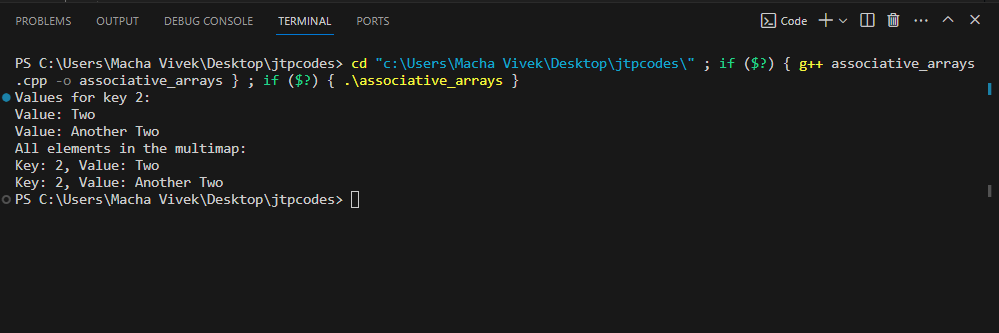Associative arrays in C++In this article, we will discuss Associative arrays in C++ with their features and examples. In C++ language, Associative arrays will refer to data structures that associate keys and values. These are efficient for storing and retrieving values based on their corresponding keys. These associative arrays are implemented using various containers provided by Standard Template Library. The primary containers for associative arrays are map and unordered_map. These containers allow us to associate keys with values. These are versatile and powerful data structures that can be used to solve a variety of problems. Essential features of the Associative arrays in C++:There are several features of the associative arrays in C++. Some main features of the associative arrays are as follows:
Each element in an associative array must only be present in a key-value pair. Where the keys are unique, each value is related to only one key. The value of the data is associated with the key.
Keys in the associative arrays can be of any kind, including integers, strings, objects or user-defined types.
These are optimized for the efficient lookup of elements based on their keys. Accessing a value using a key is faster than iterating through a traditional array.
Associative arrays can grow when a new key-value pair is added. They shrink whenever we delete or remove a key-value pair from it, so there will be no problem when dealing with the size of the arrays. Common operations in Associative Arrays:There are several common operations in associative arrays. Some main operations in the associative arrays are as follows:
This operation adds a new key-value pair to the associative arrays. It is done using the square brackets or the insert function in C++.
Accessing retrieves the value associated with a specific key. If the key is present in the array, we can access its value by using it. A new entry is created with a default constructed value if the key is not current.
Updating allows the modification of the value associated with a specific key. It will create a new key-value pair if it is not present in the array.
This operation will remove a particular key-value pair in the associative array. The erase function is commonly used for this operation.
The find function checks whether a particular key exists in the associative array. It returns the iterator pointer to the element if the key is present in the array. It returns end() if the key is not current.
The size function is present to know the size of the associative array These are the fundamental operations for manipulating and querying associative arrays in C++. These associative arrays will offer faster average lookup times. The time complexities associated with these operations, especially when dealing with large datasets. Applications of associative arrays in C++:
Now, we will discuss about some of the associative arrays:
These are implemented as sorted binary trees and maintain a sorted order of keys. It is most commonly used in programming.
It implements a hash table. It will provide faster insertion and retravel than a map. Here, the order of insertion of the key-value pair is not maintained.
It is also similar to a map, but it will allow duplicate key pairs. It means that it will enable multiple elements with the same key.
It is similar to unordered_map and is implemented by using a hash table. It allows multiple elements with the same key. Example:Let us take a C++ program to illustrate the unordered_map: Output: 
Example 2:Let us take a C++ program to illustrate the map: Output: 
Example 3:Let us take a C++ program to illustrate multimap: Output: 
Next Topicatexit() function in C++
|
 For Videos Join Our Youtube Channel: Join Now
For Videos Join Our Youtube Channel: Join Now
Feedback
- Send your Feedback to [email protected]
Help Others, Please Share










